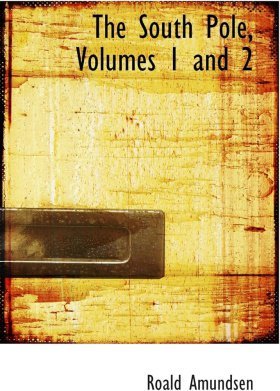At 10 p.m. on the 6th we were already out of the ice after a passage of exactly four days; we had been extremely lucky, and the Fram went very easily through the ice.
After coming out of the pack, our course was continued through the open Ross Sea to the Bay of Whales, which from the previous description was to be found in about long. 164º W. On the afternoon of the 11th we had strong ice-blink ahead, by which is meant the luminous stripe that is seen above a considerable
accumulation of ice; the nearest thing one can compare it to is the glare that is always seen over a great city on approaching it at night. We knew at once that this was the glare of the mighty Ross Barrier, named after Sir James Clark Ross, who first saw it in 1841. The Barrier is a wall of ice, several hundred miles long, and about 100 feet high, which forms the southern boundary of Ross Sea. We were, of course, very intent upon seeing what it looked like, but to me it did not appear so imposing as I had imagined it. Possibly this was because I had become familiar with it, in a way, from the many descriptions of it. From these descriptions we had expected to find a comparatively narrow opening into Balloon Bight, as shown in the photographs we had before us; but as we went along the Barrier, on the 12th, we could find no opening. In long. 164º W., on the other hand, there was a great break in the wall, forming a cape (West Cape); from here to the other side of the Barrier was about eight geographical miles, and southward, as far as we could see, lay loose bay ice. We held on to the east outside this drift-ice and along the eastern Barrier till past midnight, but as Balloon Bight was not to be found, we returned to the above-mentioned break or cape, where we lay during the whole forenoon of the 13th, as the ice was too thick to allow us to make any progress. After midday, however, the ice loosened, and began to drift out; at the same time we went in, and having gone as far as possible, the Fram was moored to the fast ice-foot on the western side of the great bay we had entered. It proved that Balloon Bight and another bight had merged to form a great bay, exactly as described by Sir Ernest Shackleton, and named by him the Bay of Whales.
After mooring here, the Chief and one or two others went on a reconnoitring tour; but it began to snow pretty thickly, and, as far as I am aware, nothing was accomplished beyond seeing that the Barrier at the southernmost end of the bay sloped evenly down to the sea-ice; but between the latter and the slope there was open water, so that they could not go any farther. We lay all night drifting in the ice, which was constantly breaking up, and during this time several seals and penguins were shot. Towards morning on the 14th it became quite clear, and we had a splendid view of the surroundings. Right over on the eastern side of the bay it looked as if there was more open water; we therefore went along the fast ice-foot and moored off the eastern Barrier at about three in the afternoon. The cape in the Barrier, under which we lay, was given the name of "Man's Head," on account of its resemblance to a human profile. All the time we were going along the ice we were shooting seals, so that on arrival at our final moorings we already had a good supply of meat.
For my part I was rather unlucky on one of these hunts: Four seals were lying on the ice-foot, and I jumped down with rifle and five cartridges; to take any cartridges in reserve did not occur to me, as, of course, I regarded myself as a mighty hunter, and thought that one shot per seal was quite enough. The three first died without a groan; but the fourth took the alarm, and made off as fast as it could. I fired my fourth cartridge, but it did not hit as it ought to have done, and the seal was in full flight, leaving a streak of blood behind it. I was not anxious to let a wounded seal go, and as I had only one cartridge left, and the seal had its tail turned towards me, I wanted to come to close quarters to make sure of it. I therefore ran as hard as I could, but the seal was quicker, and it determined the range. After running half-way to the South Pole, I summoned my remaining strength and fired the last shot. Whether the bullet went above or below, I have no idea. All I know is, that on arriving on board I was met by scornful smiles and had to stand a good deal of chaff.
As already mentioned, we left Norway on August 9, 1910, and arrived at our final moorings on January 14, 1911, in the course of which time we had only called at Madeira. The Barrier is 16,000 geographical miles from Norway, a distance which we took five months to cover. From Madeira we had had 127
days in open sea, and therewith the first part of the voyage was brought to an end.
Off the Barrier.
As soon as we had moored, the Chief, Prestrud, Johansen and I went up on to the Barrier on a tour of reconnaissance. The ascent from the sea-ice to the Barrier was fine, a perfectly even slope. When no more than a mile from the ship, we found a good site for the first dog-camp, and another mile to the south it was decided that the house was to stand, on the slope of a hill, where it would be least exposed to the strong south-easterly gales which might be expected from previous descriptions. Up on the Barrier all was absolutely still, and there was not a sign of life; indeed, what should anything live on? This delightful ski-run was extended a little farther to the south, and after a couple of hours we returned on board. Here in the meantime the slaughtering of seals had been going on, and there were plenty to be had, as several hundreds of them lay about on the ice.
After the rather long sea voyage, and the cramped quarters on board, I must say it was a pleasure to have firm ground under one's feet and to be able to move about a little. The dogs evidently thought the same; when they came down on to
the ice, they rolled in the snow and ran about, wild with delight. During our whole stay a great part of the time was spent in ski-runs and seal-hunts, and an agreeable change it was.
Sunday the 15th was spent in setting up tents at the first dog-camp and at Framheim, as the winter station was named. A team of dogs was used, and, as they were unused to being driven, it is not surprising that some lay down, others fought, a few wanted to go on board, but hardly any of them appreciated the seriousness of the situation or understood that their good time had come to an end. On Monday all the dogs were landed, and on the following day the supplies began to be put ashore.
The landing of the cases was done in this way: the sea-party brought up on deck as many cases as the drivers could take in one journey; as the sledges came down to the vessel, the cases were sent down on to the ice on skids, so that it all went very rapidly. We would not put the cases out on the ice before the sledges came back, as, in case the ice should break up, we should be obliged to heave them all on board again, or we might even lose them. At night no one was ever allowed to stay on the ice.
Before we reached the ice, we had counted on having 50 per cent. of idle days --
that is, from previous descriptions we had reckoned on having such bad weather half the time that the Fram would be obliged to leave her moorings. In this respect we were far luckier than we expected, and only had to put out twice. The first time was on the night of January 25, when we had a stiff breeze from the north with some sea, so that the vessel was bumping rather hard against the ice.
Drifting floes came down upon us, and so as not to be caught by any iceberg that might suddenly come sailing in from the point of the Barrier we called Man's Head, we took our moorings on board and went. When the shore party next morning came down as usual at a swinging pace, they saw to their astonishment that the Fram was gone. In the course of the day the weather became fine, and we tried to go back about noon; but the bay was so full of drift-ice that we could not come in to the fast ice-foot. About nine in the evening we saw from the crow's nest that the ice was loosening; we made the attempt, and by midnight we were again moored.
But the day was not wasted by the shore party, for on the day before Kristensen, L. Hansen and I had been out on ski and had shot forty seals, which were taken up to the station while we were away.
Only once or twice more did we have to leave our berth, until on February 7, when almost all the ice had left the bay, we were able to moor alongside the low, fast Barrier, where we lay in peace until we went for good.
There was a great deal of animal life about us. A number of whales came close in to the vessel, where they stayed still to look at the uninvited guests. On the ice seals came right up to the ship, as did large and small flocks of penguins, to have a look at us. These latter were altogether extraordinarily inquisitive creatures.
Two Emperor penguins often came to our last moorings to watch us laying out an ice-anchor or hauling on a hawser, while they put their heads on one side and jabbered, and they were given the names of "the Harbour-master and his Missis."
A great number of birds, skua gulls, snowy petrels and Antarctic petrels, flew round the ship and gave us many a good "roast ptarmigan."
On the morning of February 4, about 1 a.m., the watchman, Beck, came and called me with the news that a vessel was coming in. I guessed at once, of course, that it was the Terra Nova; but I must confess that I did not feel inclined to turn out and look at her. We hoisted the colours, however.
As soon as she was moored, Beck told me, some of her party went ashore, presumably to look for the house. They did not find it, though, and at 3 a.m.
Beck came below again, and said that now they were coming on board. So then I turned out and received them. They were Lieutenant Campbell, the leader of Captain Scott's second shore party, and Lieutenant Pennell, the commander of the Terra Nova. They naturally asked a number of questions, and evidently had some difficulty in believing that it was actually the Fram that was lying here. We had at first been taken for a whaler. They offered to take our mail to New Zealand; but we had no mail ready, and had to decline the offer with thanks.
Later in the day a number of the Terra Nova's officers went to breakfast at Framheim, and the Chief, Prestrud and I lunched with them. At about two in the afternoon the Terra Nova sailed again.
On Friday, February 16, a number of the shore party started on the first trip to lay down depots. We cleared up, filled our water-tanks with snow, and made the ship ready for sea. We had finished this by the evening of the 14th.
From the Bay of Whales to Buenos Aires.
The sea party consisted of the following ten men Thorvald Nilsen, L. Hansen, H.
Kristensen and J. Nödtvedt; H. F. Gjertsen, A. Beck, M. Rönne, A. Kutschin and O. K. Sundbeck. The first four formed one watch, from eight to two, and the last five the other, from two to eight. Last, but not least, comes K. Olsen, cook.
Having made ready for sea, we let go our moorings on the Ice Barrier at 9 a.m.
on February 15, 1911. Hassel, Wisting, Bjaaland, and Stubberud came down to see us off. As in the course of the last few days the ice had broken up right to the end of the bay, we went as far south as possible to take a sounding; the shallowest we got was 155 3/4 fathoms (285 metres). The bay ended in a ridge of ice on the east, which was continued in a northerly direction, so that at the spot where we were stopped by the Barrier, we reached the most southerly point that a vessel can attain, so long as the Barrier remains as it is now. Highest latitude 78º 41' S. When the Terra Nova was here, her latitude and ours was 78º
38' S.
The last two days before our departure had been calm, and a thick, dense sludge lay over the whole bay; so dense was it that the Fram lost her way altogether, and we had to keep going ahead and astern until we came out into a channel.
Seals by the hundred were lying on the floes, but as we had a quantity of seal's flesh, we left them in peace for a change.
Before the Chief began the laying out of depots, I received from him the following orders:
"To First-lieutenant Thorvald Nilsen.
With the departure of the Fram from the Ice Barrier, you will take over the command on board. In accordance with the plan we have mutually agreed upon
"1. You will sail direct to Buenos Aires, where the necessary repairs will be executed, provisions taken on board, and the crew completed. When this has been done,
"2. You will sail from Buenos Aires to carry out oceanographical observations in the South Atlantic Ocean. It would be desirable if you could investigate the conditions between South America and Africa in two sections. These investigations must, however, be dependent on the prevailing conditions, and on the time at your disposal. When the time arrives you will return to Buenos Aires, where the final preparations will be made for
"3. Your departure for the Ice Barrier to take off the shore party. The sooner you can make your way in to the Barrier in 1912, the better. I mention no time, as everything depends on circumstances, and I leave it to you to act according to your judgment.

























